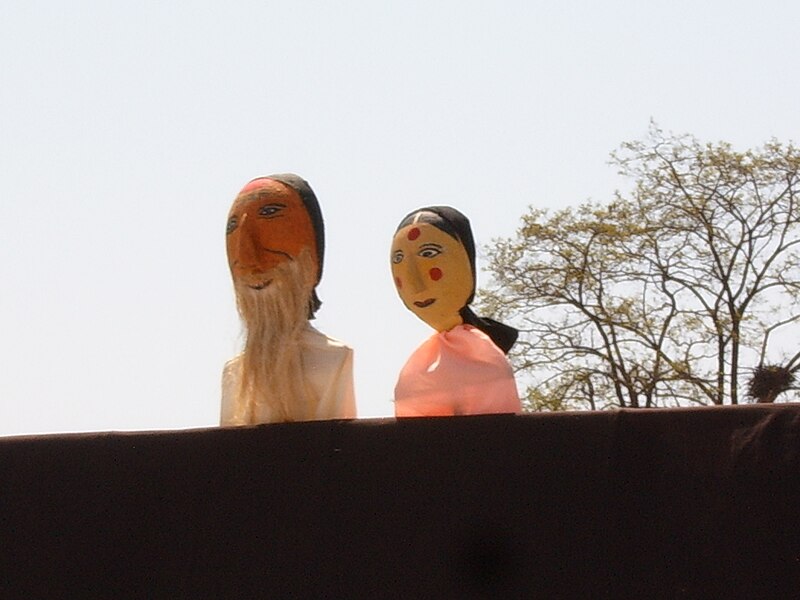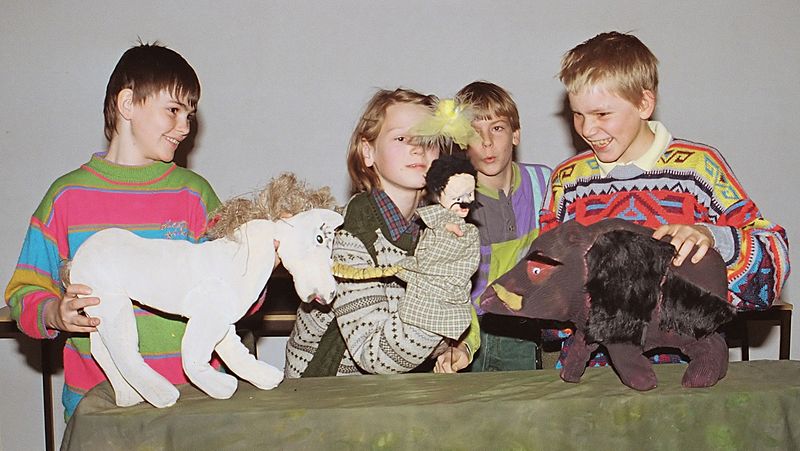Digital puppetry is the manipulation and performance of digitally animated 2D or 3D figures and objects in a virtual environment that are rendered in real time by computers. It is most commonly used in filmmaking and television production, but has also been utilized in interactive theme park attractions and live theatre.
The exact definition of what is and is not digital puppetry is subject to debate among puppeteers and computer graphics designers, but it is generally agreed that digital puppetry differs from conventional computer animation in that it involves performing characters in real time, rather than animating them frame by frame.
Digital puppetry is closely associated with motion capture technologies and 3D animation, as well as skeletal animation. Digital puppetry is also known as virtual puppetry, performance animation, living animation, live animation and real-time animation (although the latter also refers to animation generated by computer game engines). Machinima is another form of digital puppetry, and Machinima performers are increasingly being identified as puppeteers.
History and usage

Early experiments
One of the earliest pioneers of digital puppetry was Lee Harrison III. He conducted experiments in the early 1960s that animated figures using analog circuits and a cathode ray tube. Harrison rigged up a body suit with potentiometers and created the first working motion capture rig, animating 3D figures in real-time on his CRT screen. He made several short films with this system, which he called ANIMAC. Among the earliest examples of digital puppets produced with the system included a character called "Mr. Computer Image" who was controlled by a combination of the ANIMAC's body control rig and an early form of voice-controlled automatic lip sync.
Waldo C. Graphic
Perhaps the first truly commercially successful example of a digitally animated figure being performed and rendered in real-time is Waldo C. Graphic, a character created in 1988 by Jim Henson and Pacific Data Images for the Muppet television series The Jim Henson Hour. Henson had used the Scanimate system to generate a digital version of his Nobody character in real-time for the television series Sesame Street as early as 1970 and Waldo grew out of experiments Henson conducted to create a computer generated version of his character Kermit the Frog. in 1985.
Waldo's strength as a computer generated puppet was that he could be controlled by a single puppeteer (Steve Whitmire) in real-time in concert with conventional puppets. The computer image of Waldo was mixed with the video feed of the camera focused on physical puppets so that all of the puppeteers in a scene could perform together. (It was already standard Muppeteering practice to use monitors while performing, so the use of a virtual puppet did not significantly increase the complexity of the system.) Afterwards, in post production, PDI re-rendered Waldo in full resolution, adding a few dynamic elements on top of the performed motion.
Waldo C. Graphic can be seen today in Jim Henson's Muppet*Vision 3D at the Disney's Hollywood Studios and Disney California Adventure Park theme parks.
Mike Normal
Another significant development in digital puppetry in 1988 was Mike Normal, which Brad DeGraf and partner Michael Wahrman developed to show off the real-time capabilities of Silicon Graphics' then-new 4D series workstations. Unveiled at the 1988 SIGGRAPH convention, it was the first live performance of a digital character. Mike was a sophisticated talking head driven by a specially built controller that allowed a single puppeteer to control many parameters of the character's face, including mouth, eyes, expression, and head position.
The system developed by deGraf/Wahrman to perform Mike Normal was later used to create a representation of the villain Cain in the motion picture RoboCop 2, which is believed to be the first example of digital puppetry being used to create a character in a full-length motion picture.
Trey Stokes was the puppeteer for both Mike Normal's SIGGRAPH debut and Robocop II.
Sesame Street: Elmo's World
One of the most widely seen successful examples of digital puppetry in a TV series is Sesame Street's "Elmo's World" segment. A set of furniture characters were created with CGI, to perform simultaneously with Elmo and other real puppets. They were performed in real time on set, simultaneously with live puppet performances. As with the example of Henson's Waldo C. Graphic above, the digital puppets' video feed was seen live by both the digital and physical puppet performers, allowing the digital and physical characters to interact.
Cave Troll and Gollum on "The Lord of the Rings, The Fellowship of The Ring" (2001)
In 2000, Ramon Rivero was the first person to perform a digital puppet using Optical Motion Capture against pre-recorded action footage of a feature film. The character was the Cave Troll in the first episode of the The Lord of the Rings trilogy. The motion capture technology was created by Biomechanics Inc in Atlanta, Georgia (now Giant Studios). Although the final film footage was made with keyframe animation, a few seconds of Rivero's original performance is in the final film. The character Gollum, tested by Ramon and performed by Andy Serkis, was also made with the same technology. Contrary to the Cave Troll, most of the animation of Gollum made it to the final footage using the original motion captured performance.
Bugs Live
"Bugs Live" was a digital puppet of Bugs Bunny created by Phillip Reay for Warner Brothers Pictures. The puppet was created using hand drawn frames of animation that were puppeteered by Bruce Lanoil and David Barclay. The Bugs Live puppet was used to create nearly 900 minutes of live, fully interactive interviews of 2D animated Bugs character about his role in the movie Looney Tunes: Back in Action in English and Spanish. Bugs Live also appeared at the 2004 SIGGRAPH Digital Puppetry Special Session with the Muppet puppet Gonzo.
Disney theme parks
Walt Disney Imagineering has also been an important innovator in the field of digital puppetry, developing new technologies as part of its "Living Character Initiative" in Disney theme parks. In 2004 they used digital puppetry techniques to create the Turtle Talk with Crush attractions at Epcot and Disney California Adventure Park. In the attraction, a hidden puppeteer performs and voices a digital puppet of Crush, the laid-back sea turtle from Finding Nemo, on a large rear-projection screen. To the audience Crush appears to be swimming inside an aquarium and engages in unscripted, real-time conversations with theme park guests.
Disney Imagineering continued its use of digital puppetry with the Monsters Inc. Laugh Floor, a new attraction in Tomorrowland at Walt Disney World's Magic Kingdom, which opened in the spring of 2007. Guests temporarily enter the "monster world" introduced in Disney and Pixar's 2001 film, Monsters, Inc., where they are entertained by Mike Wazowski and other monster comedians who are attempting to capture laughter, which they convert to energy. Much like Turtle Talk, the puppeteers interact with guests in real-time, just as a real-life comedian would interact with his/her audience.
Disney also uses digital puppetry techniques in Stitch Encounter, which opened in 2006 at the Hong Kong Disneyland park. Disney has another version of the same attraction in Disneyland Resort Paris called Stitch Live!
Types of digital puppetry

Waldo puppetry
A digital puppet is controlled onscreen in real time by a puppeteer who uses a telemetric input device connected to the computer. The X-Y-Z axis movement of the input device causes the digital puppet to move correspondingly.
Motion capture puppetry (mocap puppetry) or Performance Animation
An object (puppet) or human body is used as a physical representation of a digital puppet and manipulated by a puppeteer. The movements of the object or body are matched correspondingly by the digital puppet in real-time.
Machinima
A production technique that can be used to perform digital puppets. Machinima involves creating computer-generated imagery (CGI) using the low-end 3D engines in video games. Players act out scenes in real-time using characters and settings within a game and the resulting footage is recorded and later edited into a finished film.
References

External links

- The Henson Digital Puppetry Wiki - Wiki for Henson Digital Puppetry projects, people, characters, and technology.
- Animata - Free, open source real-time animation software commonly used to create digital puppets.
- Mike the talking head - Web page about Mike Normal, one of the earliest examples of digital puppetry.

Posting Komentar